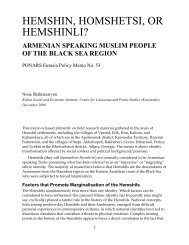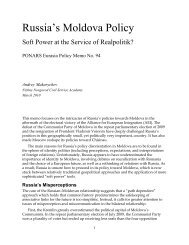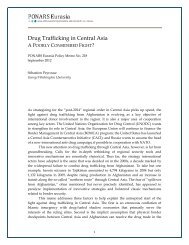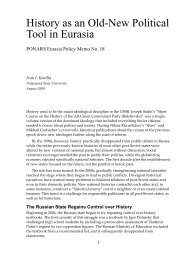View the Policy Memo (PDF) - PONARS Eurasia
View the Policy Memo (PDF) - PONARS Eurasia
View the Policy Memo (PDF) - PONARS Eurasia
Create successful ePaper yourself
Turn your PDF publications into a flip-book with our unique Google optimized e-Paper software.
<strong>the</strong> United States waged in Iraq and Afghanistan.” O<strong>the</strong>r similarities with previous post-<br />
9/11 attacks of this type abound. The cell was formed by young, U.S.-based, and<br />
relatively integrated first generation migrants of unexceptional social background. The<br />
older bro<strong>the</strong>r held a green card, while <strong>the</strong> younger was a naturalized U.S. citizen since<br />
2012. No direct connections to known extremist groups were found by <strong>the</strong> CIA or <strong>the</strong><br />
FBI, who had looked into <strong>the</strong> matter upon a lead from <strong>the</strong> Russian government. Nor was<br />
<strong>the</strong>re anything new in having a suspect that had been or was under investigation by U.S.<br />
security agencies end up plotting and committing a terrorist attack—<strong>the</strong>re have been at<br />
least four such cases in <strong>the</strong> United States since 9/11. The suspects were hardly wellversed<br />
Islamists in <strong>the</strong> religious sense, but one or both of <strong>the</strong>m were clearly inspired by<br />
<strong>the</strong> global jihadist abhorrence of U.S. actions in <strong>the</strong> Muslim world, specifically in Iraq<br />
and Afghanistan. Domestic radicalizing influences and connections in <strong>the</strong> United States,<br />
such as a potential radicalizing influence from one or more individuals and/or by<br />
previous jihadist terrorism cases, need to be fur<strong>the</strong>r explored. The Tsarnaev cell was not<br />
<strong>the</strong> first case in which Cambridge mosque-goers faced terrorism charges in <strong>the</strong> United<br />
States or abroad. While it remains to be seen how <strong>the</strong> suspects acquired weapons,<br />
explosives, and funding, one of <strong>the</strong>m bought fireworks from <strong>the</strong> same Phantom<br />
Fireworks company that sold fireworks to Times Square plotter Faisal Shahzad.<br />
Against <strong>the</strong>se similarities, <strong>the</strong>re are two distinct characteristics specific to <strong>the</strong><br />
Boston cell that do not exactly fit <strong>the</strong> pattern of previous single actor jihadist terrorism in<br />
<strong>the</strong> United States.<br />
First, <strong>the</strong> heavier-than-usual damage caused by <strong>the</strong> attack is atypical for single<br />
actor jihadist terrorist acts in <strong>the</strong> West. The Boston attack killed three people on <strong>the</strong> spot<br />
and injured over 260—an unprecedented number of casualties for a post-9/11 jihadist<br />
attack on U.S. soil. Some previous post-9/11 plots in <strong>the</strong> United States involved larger<br />
volumes of explosives but were not successful. While half of all plots of <strong>the</strong>se type in <strong>the</strong><br />
West involve plans to cause mass casualties, very few lead to actual mass-casualty<br />
attacks. In fact, <strong>the</strong>re were only three such previous cases after 2001: <strong>the</strong> 2004 Madrid<br />
bombings, <strong>the</strong> 2005 London bombings, and <strong>the</strong> 2009 Fort Hood shooting (<strong>the</strong> fourth<br />
most lethal terrorist attack in contemporary U.S. history). In all three cases, some degree<br />
of specialized expertise or professional connections was in place. This record, coupled<br />
with some indications of a higher degree of sophistication in <strong>the</strong> Boston explosive<br />
devices than what one can get from Internet manuals, suggest <strong>the</strong> presence of some<br />
specialized training or qualification in <strong>the</strong> Tsarnaevs’ case, even despite some possible<br />
elements of spontaneity (after <strong>the</strong> Boston attacks, <strong>the</strong> bro<strong>the</strong>rs were reported to have<br />
impulsively contemplated ano<strong>the</strong>r bombing at Times Square).<br />
Second, all previous single actor jihadist incidents in <strong>the</strong> United States have<br />
involved some link to ei<strong>the</strong>r Iraq and Afghanistan-Pakistan as <strong>the</strong>aters of U.S. direct<br />
military and security involvement (or, to use jihadist terminology, “open fronts” of<br />
“liberation wars”) or at least to areas where U.S. covert involvement has taken place<br />
(such as Yemen). These links went beyond general inspiration or declared justification<br />
for an attack: <strong>the</strong>y involved ei<strong>the</strong>r suspects of Afghan or Pakistani-American origin,<br />
including those who sought some direct training in <strong>the</strong>se countries, or those, like Hasan,<br />
6










